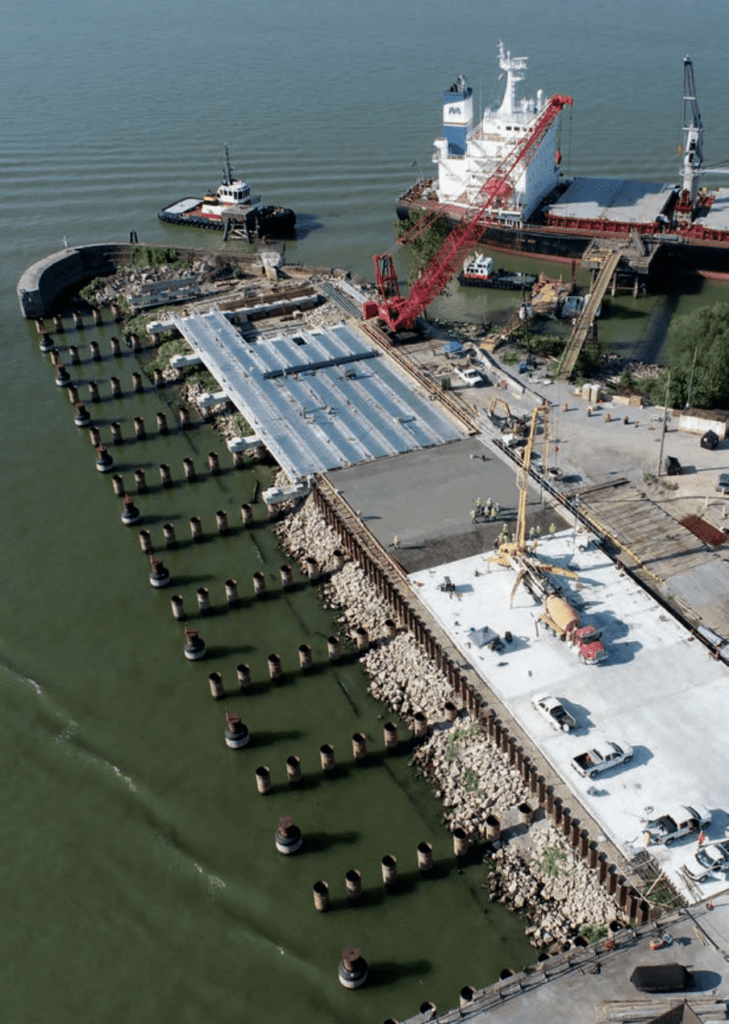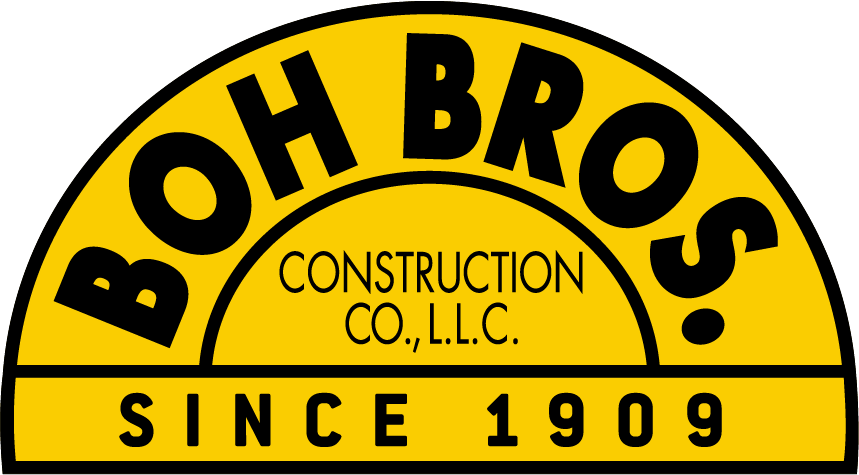
Originally built in 1907 in the Port of St. Bernard’s Arabi Terminal, the Chalmette Slip is the lone deep-draft calm water slip on the lower Mississippi River and supports one of the largest shipping corridors in the world. By the start of the 21st century, the wharfs had decayed and required significant repairs, a situation which was further worsened in 2005 when Hurricane Katrina inflicted significant damage. By the 2010s, the Port had little option but to deal with the Chalmette wharfs. In 2018, the federal government awarded the St. Bernard Port, Harbor and Terminal District $13 million to reconstruct the aging wharfs, with preconstruction beginning in 2019.
There were several factors that made this a complicated project. First, the historic Chalmette Wharfs A and F were way beyond their recommended 50- to 60-year lifespans, and, as a result, structural failures had occurred, rendering them unusable. Second, the damaged sustained during Hurricane Katrina effectively eliminated any remaining “asbuilts” of the historic structures, meaning any restoration efforts would take place without knowing what would be encountered. In planning for restoration work, the Port recognized the need to bring the wharfs back to life in a cost-effective manner.
With this in mind, the port owner knew that a Construction Management at Risk (CMAR) approach to the project gave it the best option for controlling costs, particularly given the risks associated with the scope of work. CMAR is an integrated approach to planning, design, and construction of a project, and serves the dual purpose of controlling schedule and budget, as well as ensuring quality for the owner. During nearly 30 preconstruction planning meetings over a year’s time, the team – comprised of Boh, the Port, the tenant (Associated Terminals), and the engineer (Volkert Inc.) – assigned risks and worked through constructability issues to tailor the project to the Port’s allowable budget.
“The Port’s engineer would give us a design, then we’d have a few weeks to develop a construction cost estimate, schedule and a list of clarifications,” said Patrick Ledet, Boh group manager for heavy construction, who handled a majority of the preconstruction phase of the project. “From there, we would submit the probable cost of construction to the owner and engineer for their review. That would be followed by constructability reviews.”
In practice, the design went through several iterations as the team worked collectively to save time and money. “The bottom line – we were wanting to give them the most square footage of dock space for the dollars they had. That was the end goal,” Ledet said.
By utilizing the CMAR process, the team issued an early work package to validate the pile lengths that would be needed. Boh drove steel pipe and timber test piles at each wharf location, performing a static load test on the timber piles and a statnamic test on the pipe piles. The statnamic test involves erecting a test frame loaded with a specific weight. An explosive charge is place between the pile and the weights above and detonated forcing the load down on the pile. “This provides a confirmation of the pile load,” said Grant Closson, piling and marine project manager. “Once we got the contract, we could immediately order the piles so that we weren’t exposed to increased costs for steel materials, which were volatile at the time,” explained Ledet.

Overcoming Challenges
Using a CMAR approach helped the Boh team navigate the challenges posed by unexpected conditions at the Chalmette wharfs site. The team consistently encountered instability with the existing structures, and, irrespective of their age, the integrity of the wharfs had been compromised over the years. “The existing Chalmette wharfs had been built in the dry in the early 1900s, with the slip cut in later,” Ledet said. “Since that time, the Port had dredged and deepened the slip to allow for larger and larger vessels. That created the potential for additional instability in the existing structures.
Several years prior to the project, a 28-foot-tall section of wharf wall collapsed during a previous attempt to rehabilitate Wharf A; so as a first step, the Boh team began removing it in 2021, piece by piece. The Boh team extracted 100-ton pieces of the structure using a 400-ton derrick crane. It was a delicate operation since any dropped concrete would have to be retrieved from the water.
Later, the Boh team discovered an existing timber retaining wall below the water line that fell directly in line with some of the new steel pipe pile locations. “We didn’t discover it until we had demolished the existing structure and the water level dropped enough to reveal it,” said Stephen Bernard, group manager for heavy construction. “We eventually put a track hoe on a barge to selectively remove the pieces that obstructed the pile driving.”
As they worked through these issues, the Boh team began driving steel pipe piles for Wharf A (located on the southwest side of the slip) while the demolition subcontractor began work on Wharf F (on the northeast side). The piles measured 48 inches in diameter and were 160 feet long. The pile installation process was aided by an adjustable steel template designed by Neil Hickok, Boh’s chief engineer, and fabricated in the company’s New Orleans East yard. The template was floated into location and temporary piles were driven before the template was raised above the water. “The second pile template was placed across the floating template and permanent piles were then driven into place,” said Closson. “We frequently use this method, but this was on a much larger scale.”
Simultaneously, the Boh team began driving heavy duty 60-foot-long sheet piles (NZ-38) to protect the land portion of the work. “The river was high at the time, so we had to drive the sheeting in the water,” he added. “That added another layer of complexity to the project.”
Shifting Soils
The global instability of the site became the primary issue for the project team. “It considerably impacted the sequence of the project,” Bernard said. “For example, the original plans called for us to leave a section of the existing wharf in place and we would build on top of it, but it failed during demolition. We worked closely with the engineer to develop alternative construction methods to determine how to access and safely remove the structure.”
Though the project planning afforded a degree flexibility to navigate delays and proactively address concerns, complications emerged at each stage. After sheet piles were driven and the area backfilled with sand, the Boh team discovered another issue: “the sheet pile wall began to move outward due to the heaving of the soil from timber pile installation,” Bernard said. “At that point, the engineer halted the project and asked us to remove all of the equipment to reduce the weight on the project area, while the team regrouped.”
Over several months, the team worked through numerous design iterations before opting to replace the sand material with lightweight aggregate to reduce the lateral loading on the sheet pile wall. Additionally, the Boh team brought in a 200-ton crane so that it could drive nearly 700 timber piles – needed for a land-based section of the wharf – from a farther distance.
“As we drove the timber piles, the sheet pile wall continued to move,” Bernard said. Quickly pivoting, the Boh team then shifted the pile driving operation away from the sheet pile wall to give them time to work with Volkert to develop a solution. The Boh team experimented with a variety of pile types near the wall, while monitoring for movement, to determine the best method for minimizing the wall movement during pile installation. In the end, pipe piles were found to be an effective substitute for the timber.
Nevertheless, the sheet pile wall had shifted some 22 inches once pile driving was complete. The 48” pipe piles had moved as well, requiring the Boh team to adapt or replace some 30 precast concrete caps that had already been cast in the New Orleans East yard. Once these obstacles were overcome, however, the team proceeded swiftly with precast cap modifications, girders and deck to complete the new wharf.
Construction of Wharf F closely followed the same sequence, although the work had to be broken into two phases to maintain Associated Terminals’ access to their facilities.
Since many of the conditions encountered at the Wharf A site were similar to those at Wharf F, the Boh team was able to apply lessons learned during the previous work. Most significantly, they opted to install the concrete caps immediately after the steel pipe piles were in place to minimize lateral movement. Additionally, the team utilized a hydraulic, non-vibration installation press-in method to drive the sheet piles to avoid destabilizing the soil and damaging nearby structures. This proved successful as the movement of the steel pipe piles was reduced to just 2 inches.

Keeping the Client in Mind
Throughout the project, the Boh team remained in continuous communication with Associated Terminals to accommodate ship traffic in the slip. “We would get a call saying a ship was coming in, and that we needed to move immediately,” said Alysse Williams, assistant project manager. “If we had a load suspended on a crane, we’d have to set it down and get out of the way.”
To avoid further impacts to shipping traffic, the Boh team designed and constructed a pile-supported concrete pad for a large crane – a 300-ton crawler crane – to minimize the use of its barge-mounted marine crane. “The slip is extremely active,” Bernard says. “We didn’t want to be in the way. It also mitigated the risk to the owner as we didn’t have to stop work as frequently.”
He says the relationships developed during the early CMAR discussions undoubtedly helped the team navigate through the numerous issues encountered on the job. It laid the groundwork for a more collaborative approach to project management and enabled the team to swiftly develop efficient constructible solutions during each design iteration. “We worked closely with the engineer to mitigate costs while continuing to work … all to keep the project moving forward.”

Recent Comments